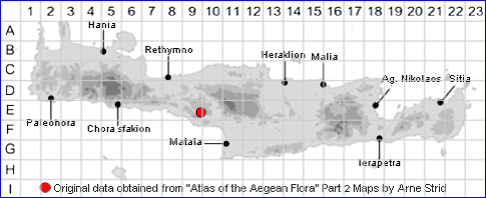
DIANTHUS JUNIPERINUS subsp. PULVINIFORMIS
Family:- CARYOPHYLLACEAE
Common Names:- None
Synonyms:- None
Meaning:- Dianthus (Gr) Zeus'-flower. a name used by the Greek philosopher
Theophrastus.
Juniperinus (L) Bluish-brown, juniper-like, (the colour of the berry).
Pulviniformis (L) Having cushion-shaped swellings, cushion-like.
General description:- Dwarf shrub forming rounded hummocks.
Stems:-
1) Flowering, 3-5 cm, slender, 2- or 3-flowered.
Leaves:-
1) Leaves of young branches 1-1·5 cm, needle-like, densely crowded.
Flowers:-
1) Epicalyx-scales, c. ½ as long as the calyx, with a slender mucro 1-1·5 mm.
2) Calyx, 7-8 mm.
3) Petal-limb, 3-4 mm wide, obovate, cuneate, shortly and sharply dentate, white
Fruit:-
Habitat:- Limestone rocks, c. 600 m.
Distribution:- Endemic to Mount Kedros SW Crete. Very rare.
Flowering time:- June-July
Photos by:- Christopher Cheiladakis
Status:-
Conservation status (for threatened species): Critical (CR) according to IUCN
1997.
Protection status (for threatened species): Greek Presidential Decree 67/1981.
SPECIES DESCRIPTION
